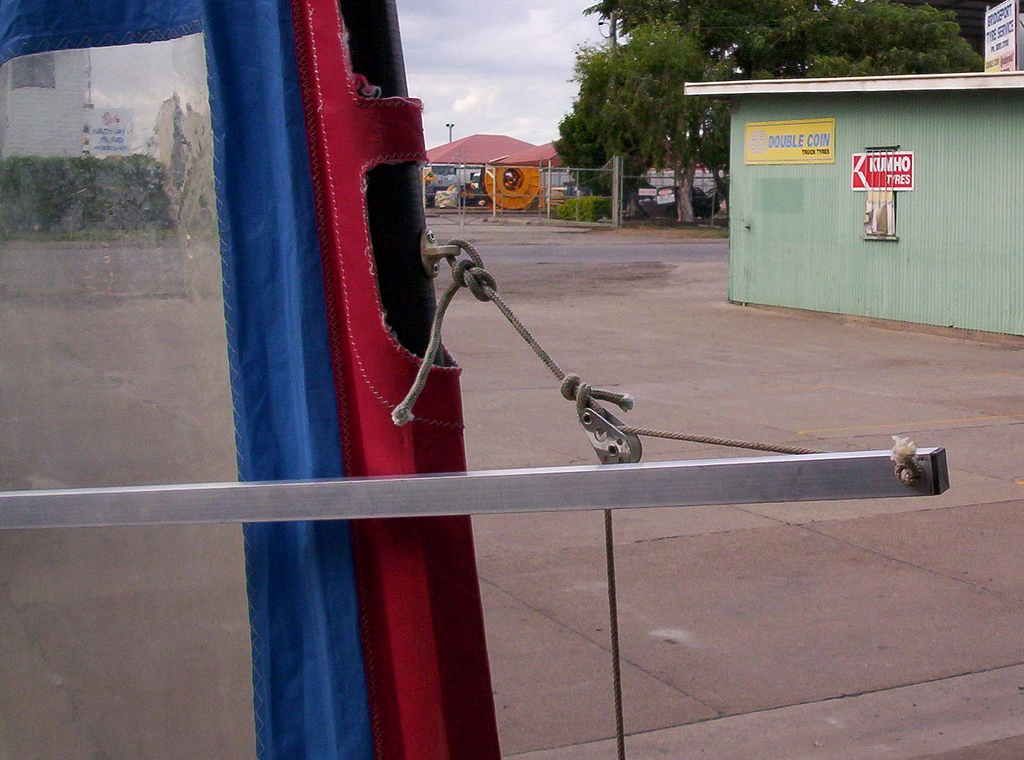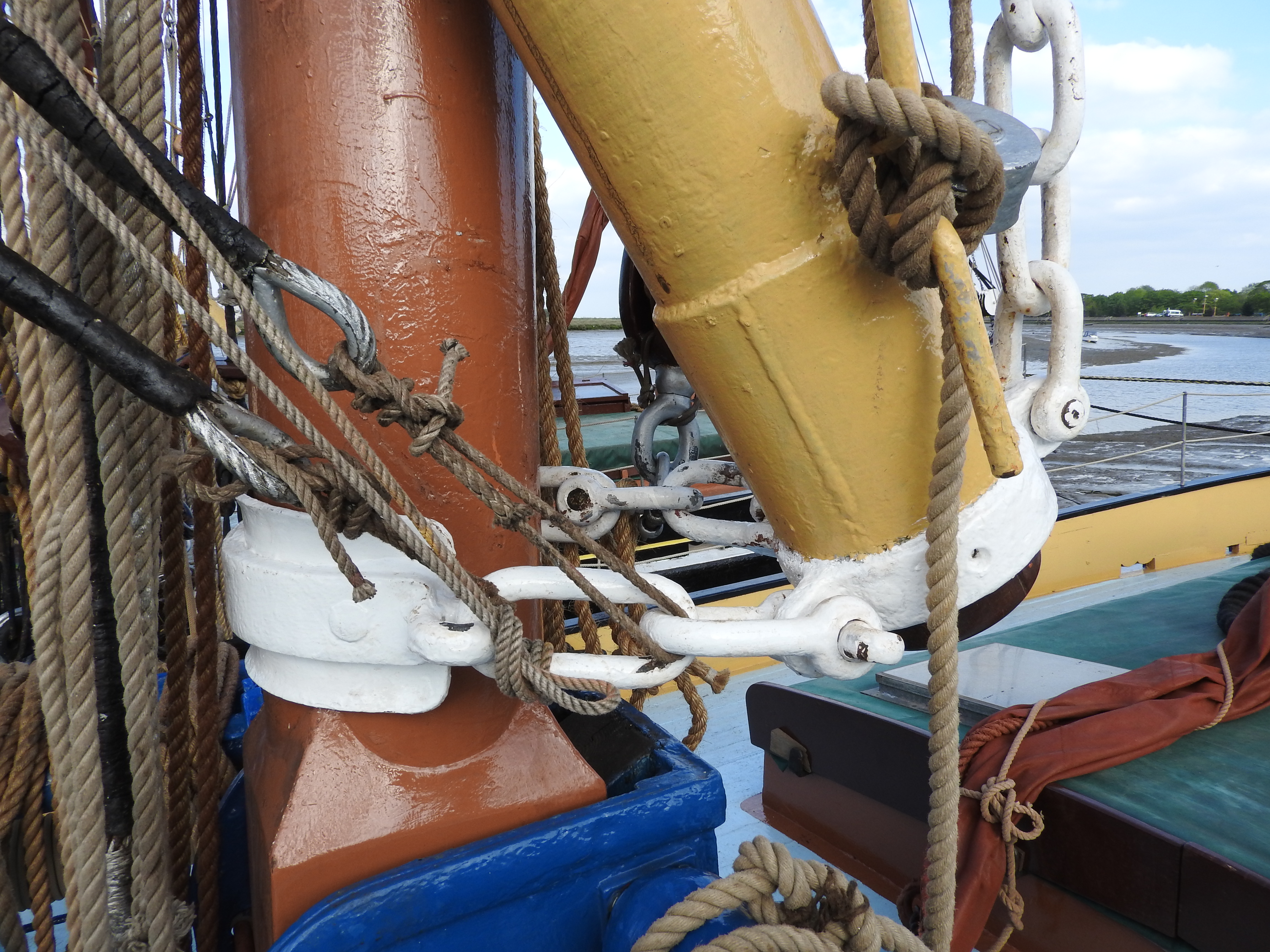|
Snotter
A snotter is a rope or tackle used in sailing to tension the sprit on a spritsail, or a sprit boom on a sprit-boomed sail by pulling the lower end towards the mast. It is also used in a junk rig. There are a great many variations on the snotter arrangement, and some more fastidious authors have referred to it as a ''snouter'' or ''snorter''. The origin of the nautical term is obscure. Hauling on the snotter sets the tension in the spar and thus governs how the sail is set. On very small boats, typically with a single boomless spritsail, the snotter is a rope with eyes spliced into it, and is merely hooked into the fore end of the sprit and then jammed up the mast to force the upper end of the sprit into a pocket in the sail. Spritsail There are ''boomed spritsails'', ''loose-footed spritsails'' and ''boomless spritsails''. Sprit Booms The most common sprit-boom is found on a ''sprit-boomed leg-of-mutton sail''. Sprit booms have been combined with a leech spar called a ''c ... [...More Info...] [...Related Items...] OR: [Wikipedia] [Google] [Baidu] |
Snotter
A snotter is a rope or tackle used in sailing to tension the sprit on a spritsail, or a sprit boom on a sprit-boomed sail by pulling the lower end towards the mast. It is also used in a junk rig. There are a great many variations on the snotter arrangement, and some more fastidious authors have referred to it as a ''snouter'' or ''snorter''. The origin of the nautical term is obscure. Hauling on the snotter sets the tension in the spar and thus governs how the sail is set. On very small boats, typically with a single boomless spritsail, the snotter is a rope with eyes spliced into it, and is merely hooked into the fore end of the sprit and then jammed up the mast to force the upper end of the sprit into a pocket in the sail. Spritsail There are ''boomed spritsails'', ''loose-footed spritsails'' and ''boomless spritsails''. Sprit Booms The most common sprit-boom is found on a ''sprit-boomed leg-of-mutton sail''. Sprit booms have been combined with a leech spar called a ''c ... [...More Info...] [...Related Items...] OR: [Wikipedia] [Google] [Baidu] |
Sprit
The spritsail is a four-sided, fore-and-aft sail that is supported at its highest points by the mast and a diagonally running spar known as the sprit. The foot of the sail can be stretched by a boom or held loose-footed just by its sheets. A spritsail has four corners: the throat, peak, clew, and tack. The Spritsail can also be used to describe a rig that uses a spritsail. Historically, spritsails were the first European fore-and-aft rigs, appearing in Greco-Roman navigation in the 2nd century BC. The rig The luff of the sail is bound to the mast, but unlike the gaff rig where the head is bound to a spar, this rig supports the leech of the sail by means of a diagonal spar or spars named a sprit ( ). The forward end of the sprit spar is attached to the mast, with the after end of the sprit spar attached to the peak. The sprit is steadied and controlled from the deck by a pair of wire vangs ( ) attached to the peak of the sail. It is said to be the ancestor of the common g ... [...More Info...] [...Related Items...] OR: [Wikipedia] [Google] [Baidu] |
Spritsail
The spritsail is a four-sided, fore-and-aft sail that is supported at its highest points by the mast and a diagonally running spar known as the sprit. The foot of the sail can be stretched by a boom or held loose-footed just by its sheets. A spritsail has four corners: the throat, peak, clew, and tack. The Spritsail can also be used to describe a rig that uses a spritsail. Historically, spritsails were the first European fore-and-aft rigs, appearing in Greco-Roman navigation in the 2nd century BC. The rig The luff of the sail is bound to the mast, but unlike the gaff rig where the head is bound to a spar, this rig supports the leech of the sail by means of a diagonal spar or spars named a sprit ( ). The forward end of the sprit spar is attached to the mast, with the after end of the sprit spar attached to the peak. The sprit is steadied and controlled from the deck by a pair of wire vangs ( ) attached to the peak of the sail. It is said to be the ancestor of the common ga ... [...More Info...] [...Related Items...] OR: [Wikipedia] [Google] [Baidu] |
Sailing
Sailing employs the wind—acting on sails, wingsails or kites—to propel a craft on the surface of the ''water'' (sailing ship, sailboat, raft, windsurfer, or kitesurfer), on ''ice'' (iceboat) or on ''land'' (land yacht) over a chosen course, which is often part of a larger plan of navigation. From prehistory until the second half of the 19th century, sailing craft were the primary means of maritime trade and transportation; exploration across the seas and oceans was reliant on sail for anything other than the shortest distances. Naval power in this period used sail to varying degrees depending on the current technology, culminating in the gun-armed sailing warships of the Age of Sail. Sail was slowly replaced by steam as the method of propulsion for ships over the latter part of the 19th century – seeing a gradual improvement in the technology of steam through a number of stepwise developments. Steam allowed scheduled services that ran at higher average speeds than sail ... [...More Info...] [...Related Items...] OR: [Wikipedia] [Google] [Baidu] |
Lug Sail
The lug sail, or lugsail, is a fore-and-aft, four-cornered sail that is suspended from a spar, called a yard. When raised, the sail area overlaps the mast. For "standing lug" rigs, the sail may remain on the same side of the mast on both the port and starboard tacks. For "dipping lug" rigs, the sail is lowered partially or totally to be brought around to the leeward side of the mast in order to optimize the efficiency of the sail on both tacks. The lug sail is evolved from the square sail to improve how close the vessel can sail into the wind. Square sails, on the other hand, are symmetrically mounted in front of the mast and are manually angled to catch the wind on opposite tacks. Since it is difficult to orient square sails fore and aft or to tension their leading edges ( luffs), they are not as efficient upwind, compared with lug sails. The lug rig differs from the gaff rig, also fore-and-aft, whose sail is instead attached at the luff to the mast and is suspended from a spar ... [...More Info...] [...Related Items...] OR: [Wikipedia] [Google] [Baidu] |




